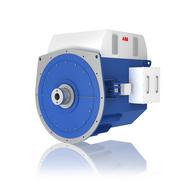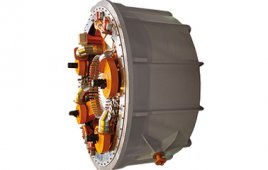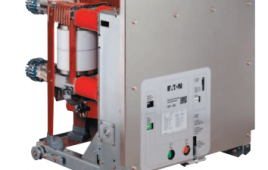The wind industry uses induction and permanent magnet designs. There are many variations of these two, but in general terms, the induction generator must be spun at about 1,000 rpm or more to produce useful power. It produces current by first generating an electric field by passing current through a coil. A series of these coils are mounted on a rotating structure (a rotor) that is turned by the wind through the drive train. Surrounding the rotor is a stationary series of coils, a stator. When the magnetic fields on the rotor pass coils on the stator, the fields induce a current in the stator coils which is conducted away as output. Induction generators are not self-exciting. That means they require an external power source to produce an initial magnetic flux or field.
PM or permanent-magnet generators use the magnetic field generated by magnets mounted on a rotor. Variations on this design put magnets on the stator and let the coils rotate. There are advantages to each.
The wind industry prefers magnets made of relatively expensive rare-earth elements for the field strength they generate. They are worth the expense because the PM generator then needs no external power source to initiate a magnetic field, an advantage for wind farms in remote locations. Selfexcitation also means a bank of batteries or capacitors for other functions can be smaller.
Other plusses for PM generators are that the high energy density eliminates some weight associated with copper windings, along with problems of degrading insulation and shorting. Another great advantage of PM generators is that a large-diameter design allows dispensing with the potentially troublesome gearbox.
On the downside, rare-earth magnets do not tolerate high temperatures. They can permanently lose magnetic field strength, which demands more from a generator’s cooling equipment. In addition, the cost of rare-earth-permanent magnets is a concern because key raw materials, mostly from China, are not available in significant quantities in the U.S. However, with the rise in PM costs, sources other China will likely come online in the next few years. That will keep prices in what has been a recent downward trend.
In addition, because gearboxes are expensive to maintain, wind turbine designers have been experimenting and commissioning turbines with drivetrains that have no gearboxes. This makes PM generators essential. Still, the PM generator in multi-megawatt machines call for a certain circumferential speed to function properly. This means the generator may be 5 to 6-m in diameter, and this size loses its weight advantage.
The solution may be a hybrid design in which a one or two-stage gearbox increases the rotational speed to provide a required output. This hybrid design also allows a lowest weight drivetrain, lighter than a direct drive design for a given power production.
Future generator designs may get around the rare-earth cost penalty and weight handicaps by using superconductive materials that work at temperatures a few degrees above absolute zero. These would also allow generators in 10 to 15-MW range without the weight penalty of conventional designs. At least two superconducting generator concepts are in development but don’t expect to see prototypes for at least three years.
Filed Under: Generators




